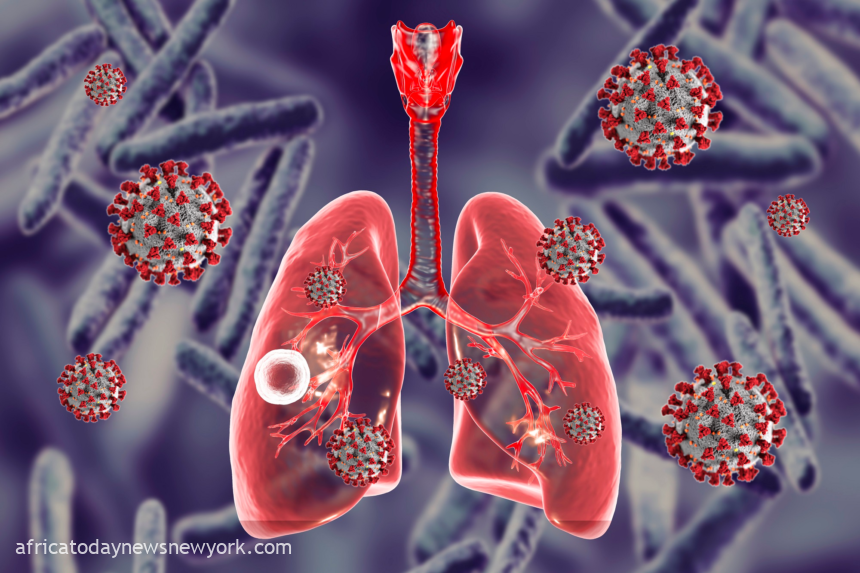Dr. Matshidiso Moeti, the Regional Director for Africa at the World Health Organization (WHO), disclosed that approximately 2.5 million individuals were diagnosed with Tuberculosis in Africa in 2022, translating to one person being affected every 13 seconds.
Additionally, Moeti highlighted that the tally of TB fatalities in 2022 climbed to 424,000, leading to the loss of one life every minute – a poignant reminder of the human cost, despite the preventable and treatable nature of TB.
This statement was made within the context of her message commemorating World TB Day, an annual event observed on March 24th to raise awareness about the significance of the disease.
The World Health Organization (WHO) states that Tuberculosis (TB) is a bacterial infection caused by Mycobacterium tuberculosis, predominantly affecting the lungs.
Transmission occurs via the air when individuals with pulmonary TB cough, sneeze, or spit, expelling infectious droplets. Infection can transpire with the inhalation of just a small quantity of these bacteria.
According to the World Health Organization (WHO), a total of 1.3 million individuals lost their lives to Tuberculosis (TB) in 2022, with 167,000 of those deaths occurring in individuals co-infected with HIV.
Globally, TB stands as the second leading infectious cause of death, surpassing HIV and AIDS, and following closely behind COVID-19. The WHO also reported that an estimated 10.6 million people fell ill with TB worldwide in 2022, comprising 5.8 million men, 3.5 million women, and 1.3 million children.
Moeti said since the 72nd session of the WHO Regional Committee for Africa in Lomé, Togo, in 2022, there has been a 20 per cent increase in identified paediatric TB cases compared to the previous year.
Read also: Kaduna Records 2,428 Cases Of Tuberculosis
“This signifies a positive step, indicating a more practical approach to recognizing TB in children and a decisive push to end this ancient disease.
“Today, we reflect on our progress while recognising the challenges in our efforts to eliminate it as a public health threat.
“TB continues to be the second leading cause of death from a single infectious agent, surpassing the toll of HIV/AIDS. According to the latest report, about 2.5 million individuals contracted TB in 2022 in the region, equating to one person every 13 seconds.
“Additionally, the number of TB deaths in 2022 reached 424,000, resulting in the loss of one life every minute—even when TB is preventable and treatable. These figures underscore the urgency of our collective action in addressing the ongoing TB epidemic and highlight the need for sustained efforts to end it,” she said.
She stated that the WHO African Region supports member states’ fight against TB in Africa by setting strategic directions, developing monitoring tools, like the African TB scorecard with the African Union, and ensuring progress towards the End TB Strategy.
She also stated that the organisation is dedicated to generating and sharing knowledge on effective TB control methods.
“We support countries by updating TB treatment guidelines to reflect the latest practices and expanding access to rapid diagnostic tools. Emphasising the importance of regional cooperation, the WHO African Region encourages knowledge exchange and collaborative efforts across countries, significantly advancing the mission to eliminate TB as a public health threat in Africa.
“In the WHO African Region, we celebrate another milestone: diagnosing 70 per cent of TB patients, marking a substantial reduction in missed cases and propelling us closer to our goal. This achievement is a testament to the relentless efforts of our Member States and partners, showcasing what can be accomplished through a shared vision and concerted action.
“Between 2015 and 2022, our region achieved a remarkable 38 per cent reduction in TB deaths, surpassing the initial End TB Strategy milestone of 35 per cent by 2020. From 2015 to 2022, the region also saw a 23 per cent reduction in new TB cases, exceeding the initial End TB Strategy target of 20 per cent by 2020. All this underscores the effectiveness of implemented strategies and renewed commitment from countries,” she added.
However, she pointed out that despite the commendable decline in TB fatalities, it remains below the target set by the 2025 End TB Strategy, which aims for a 75 percent reduction.
She noted that the 23 percent decrease in TB incidence falls short of the 50 percent reduction target set for 2025. As a result, she stressed the importance of persistent and escalated actions to attain these ambitious goals.

